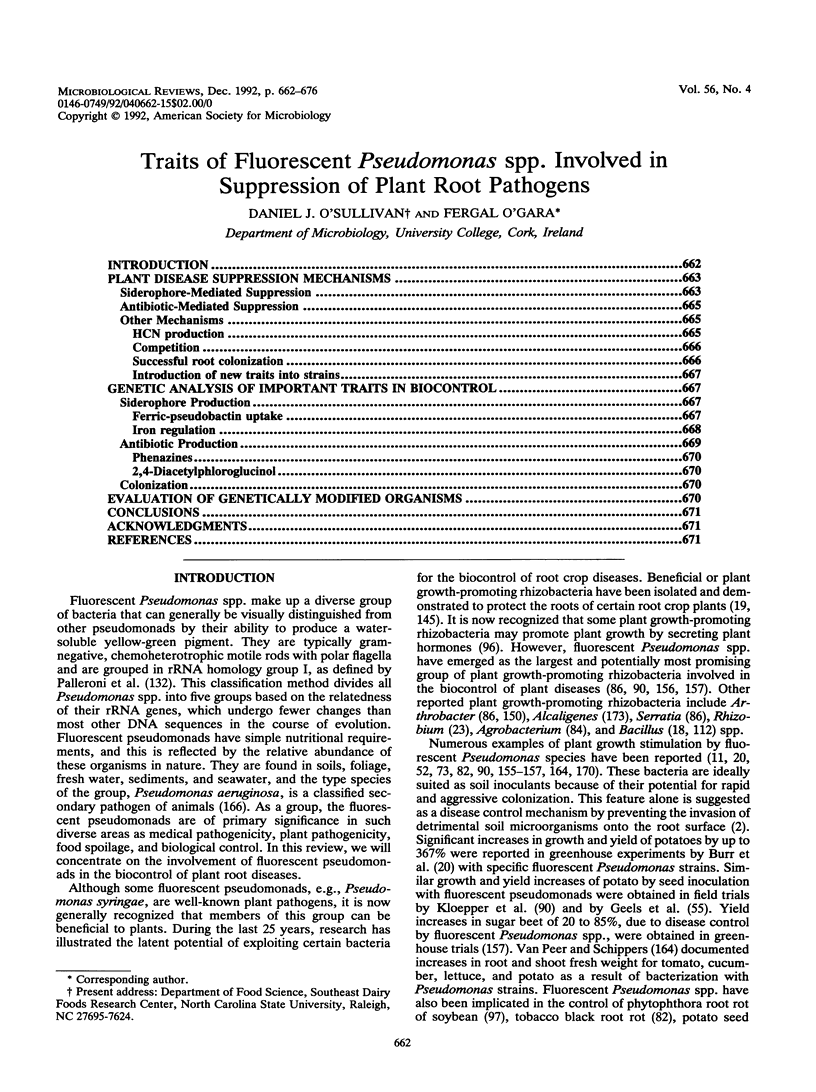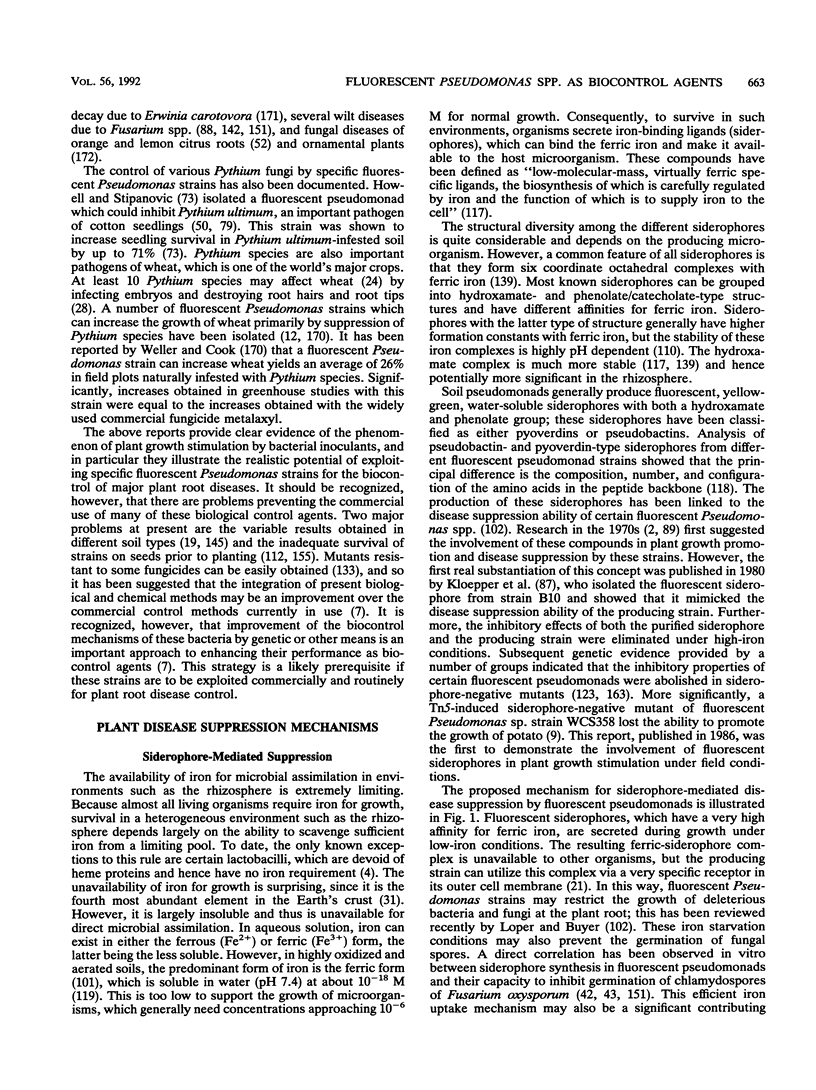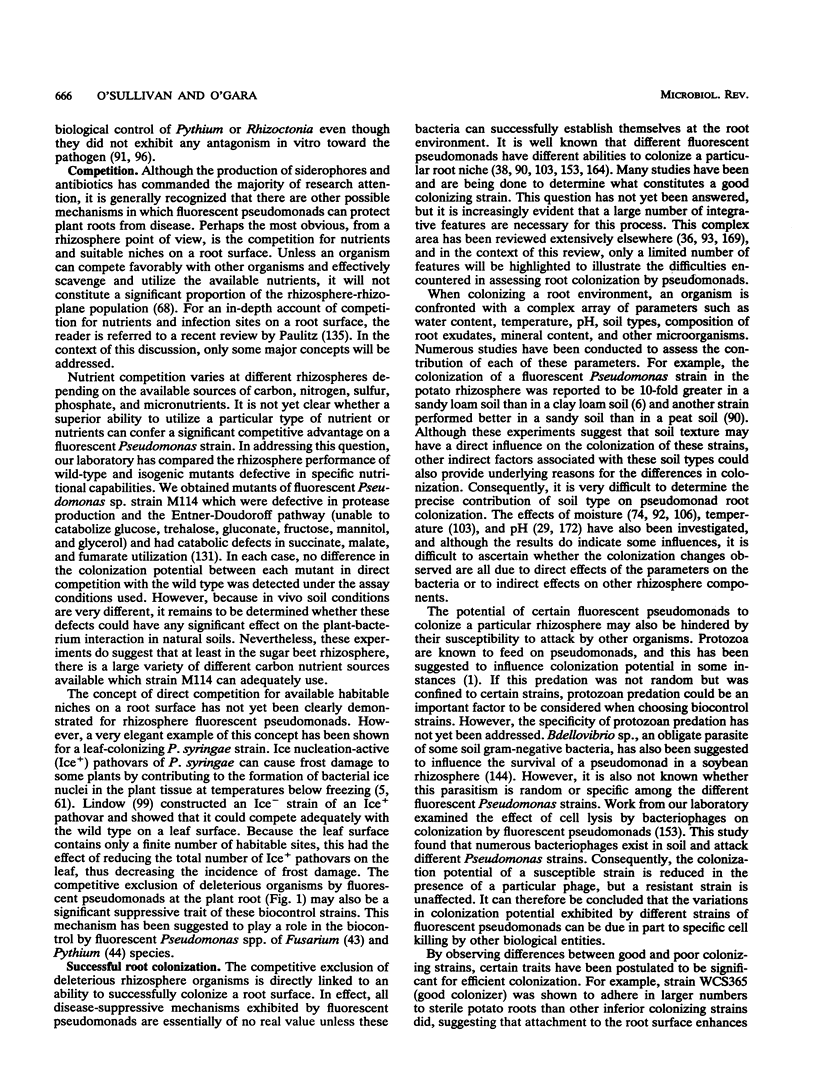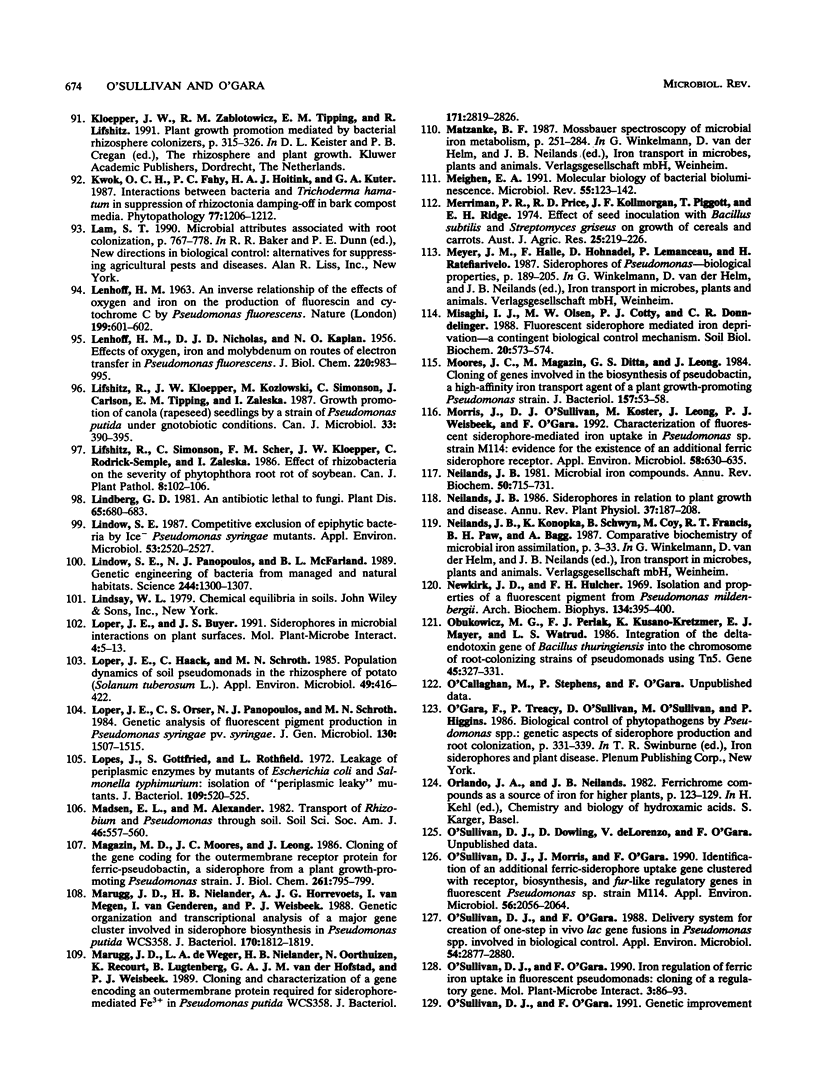Abstract
Certain members of the fluorescent pseudomonad group have been shown to be potential agents for the biocontrol of plant root diseases. The major problems with the commercialization of these beneficial strains are that few wild-type strains contain all the desired characteristics for this process and the performance of strains in different soil and climatic conditions is not reproducible. Consequently, prior to selection and/or improvement of suitable strains for biocontrol purposes, it is necessary to understand the important traits required for this purpose. The production of fluorescent siderophores (iron-binding compounds) and antibiotic compounds has been recognized as important for the inhibition of plant root pathogens. Efficient root colonization is also a prerequisite for successful biocontrol strains. This review discusses some of the characteristics of fluorescent pseudomonads that have been suggested to be important for biocontrol. The genetic organization and regulation of these processes is also examined. This information is necessary for attempts aimed at the improvement of strains based on deregulating pathways or introducing traits from one strain to another. The release of genetically engineered organisms into the environment is governed by regulations, and this aspect is summarized. The commercialization of fluorescent pseudomonads for the biological control of plant root diseases remains an exciting possibility. The understanding of the relevant characteristics will facilitate this process by enabling the direct selection and/or construction of strains which will perform under a variety of environmental conditions.
Full text
PDF














Selected References
These references are in PubMed. This may not be the complete list of references from this article.
- Anderson A. J., Habibzadegah-Tari P., Tepper C. S. Molecular Studies on the Role of a Root Surface Agglutinin in Adherence and Colonization by Pseudomonas putida. Appl Environ Microbiol. 1988 Feb;54(2):375–380. doi: 10.1128/aem.54.2.375-380.1988. [DOI] [PMC free article] [PubMed] [Google Scholar]
- Becker J. O., Hedges R. W., Messens E. Inhibitory effect of pseudobactin on the uptake of iron by higher plants. Appl Environ Microbiol. 1985 May;49(5):1090–1093. doi: 10.1128/aem.49.5.1090-1093.1985. [DOI] [PMC free article] [PubMed] [Google Scholar]
- Bej A. K., Perlin M. H., Atlas R. M. Model suicide vector for containment of genetically engineered microorganisms. Appl Environ Microbiol. 1988 Oct;54(10):2472–2477. doi: 10.1128/aem.54.10.2472-2477.1988. [DOI] [PMC free article] [PubMed] [Google Scholar]
- Bitter W., Marugg J. D., de Weger L. A., Tommassen J., Weisbeek P. J. The ferric-pseudobactin receptor PupA of Pseudomonas putida WCS358: homology to TonB-dependent Escherichia coli receptors and specificity of the protein. Mol Microbiol. 1991 Mar;5(3):647–655. doi: 10.1111/j.1365-2958.1991.tb00736.x. [DOI] [PubMed] [Google Scholar]
- Bjorn M. J., Sokol P. A., Iglewski B. H. Influence of iron on yields of extracellular products in Pseudomonas aeruginosa cultures. J Bacteriol. 1979 Apr;138(1):193–200. doi: 10.1128/jb.138.1.193-200.1979. [DOI] [PMC free article] [PubMed] [Google Scholar]
- Brisbane P. G., Janik L. J., Tate M. E., Warren R. F. Revised structure for the phenazine antibiotic from Pseudomonas fluorescens 2-79 (NRRL B-15132). Antimicrob Agents Chemother. 1987 Dec;31(12):1967–1971. doi: 10.1128/aac.31.12.1967. [DOI] [PMC free article] [PubMed] [Google Scholar]
- Buyer J. S., Leong J. Iron transport-mediated antagonism between plant growth-promoting and plant-deleterious Pseudomonas strains. J Biol Chem. 1986 Jan 15;261(2):791–794. [PubMed] [Google Scholar]
- Chakrabarty A. M., Roy S. C. Effect of trace elements on the production of pigments by a pseudomonad. Biochem J. 1964 Nov;93(2):228–231. doi: 10.1042/bj0930228. [DOI] [PMC free article] [PubMed] [Google Scholar]
- Chakraborty U., Purkayastha R. P. Role of rhizobitoxine in protecting soybean roots from Macrophomina phaseolina infection. Can J Microbiol. 1984 Mar;30(3):285–289. doi: 10.1139/m84-043. [DOI] [PubMed] [Google Scholar]
- Cline G. R., Reid C. P., Powell P. E., Szaniszlo P. J. Effects of a hydroxamate siderophore on iron absorption by sunflower and sorghum. Plant Physiol. 1984 Sep;76(1):36–39. doi: 10.1104/pp.76.1.36. [DOI] [PMC free article] [PubMed] [Google Scholar]
- Cox C. D. Iron reductases from Pseudomonas aeruginosa. J Bacteriol. 1980 Jan;141(1):199–204. doi: 10.1128/jb.141.1.199-204.1980. [DOI] [PMC free article] [PubMed] [Google Scholar]
- Crichton R. R., Charloteaux-Wauters M. Iron transport and storage. Eur J Biochem. 1987 May 4;164(3):485–506. doi: 10.1111/j.1432-1033.1987.tb11155.x. [DOI] [PubMed] [Google Scholar]
- De Weger L. A., van der Vlugt C. I., Wijfjes A. H., Bakker P. A., Schippers B., Lugtenberg B. Flagella of a plant-growth-stimulating Pseudomonas fluorescens strain are required for colonization of potato roots. J Bacteriol. 1987 Jun;169(6):2769–2773. doi: 10.1128/jb.169.6.2769-2773.1987. [DOI] [PMC free article] [PubMed] [Google Scholar]
- Dershaw D. D., Scher H. I. Serial transabdominal sonography of bladder cancer. AJR Am J Roentgenol. 1988 May;150(5):1055–1059. doi: 10.2214/ajr.150.5.1055. [DOI] [PubMed] [Google Scholar]
- Ernst J. F., Bennett R. L., Rothfield L. I. Constitutive expression of the iron-enterochelin and ferrichrome uptake systems in a mutant strain of Salmonella typhimurium. J Bacteriol. 1978 Sep;135(3):928–934. doi: 10.1128/jb.135.3.928-934.1978. [DOI] [PMC free article] [PubMed] [Google Scholar]
- Fuchs R. L., McPherson S. A., Drahos D. J. Cloning of a Serratia marcescens Gene Encoding Chitinase. Appl Environ Microbiol. 1986 Mar;51(3):504–509. doi: 10.1128/aem.51.3.504-509.1986. [DOI] [PMC free article] [PubMed] [Google Scholar]
- GARIBALDI J. A., NEILANDS J. B. Formation of iron-binding compounds by micro-organisms. Nature. 1956 Mar 17;177(4507):526–527. doi: 10.1038/177526a0. [DOI] [PubMed] [Google Scholar]
- Gambello M. J., Iglewski B. H. Cloning and characterization of the Pseudomonas aeruginosa lasR gene, a transcriptional activator of elastase expression. J Bacteriol. 1991 May;173(9):3000–3009. doi: 10.1128/jb.173.9.3000-3009.1991. [DOI] [PMC free article] [PubMed] [Google Scholar]
- Georgia F. R., Poe C. F. Study of Bacterial Fluorescence in Various Media: I. Inorganic Substances Necessary for Bacterial Fluorescence. J Bacteriol. 1931 Nov;22(5):349–361. doi: 10.1128/jb.22.5.349-361.1931. [DOI] [PMC free article] [PubMed] [Google Scholar]
- Gill P. R., Jr, Warren G. J. An iron-antagonized fungistatic agent that is not required for iron assimilation from a fluorescent rhizosphere pseudomonad. J Bacteriol. 1988 Jan;170(1):163–170. doi: 10.1128/jb.170.1.163-170.1988. [DOI] [PMC free article] [PubMed] [Google Scholar]
- Gross D. C., Cody Y. S., Proebsting E. L., Radamaker G. K., Spotts R. A. Distribution, population dynamics, and characteristics of ice nucleation-active bacteria in deciduous fruit tree orchards. Appl Environ Microbiol. 1983 Dec;46(6):1370–1379. doi: 10.1128/aem.46.6.1370-1379.1983. [DOI] [PMC free article] [PubMed] [Google Scholar]
- Gurusiddaiah S., Weller D. M., Sarkar A., Cook R. J. Characterization of an antibiotic produced by a strain of Pseudomonas fluorescens inhibitory to Gaeumannomyces graminis var. tritici and Pythium spp. Antimicrob Agents Chemother. 1986 Mar;29(3):488–495. doi: 10.1128/aac.29.3.488. [DOI] [PMC free article] [PubMed] [Google Scholar]
- Gutterson N. I., Layton T. J., Ziegle J. S., Warren G. J. Molecular cloning of genetic determinants for inhibition of fungal growth by a fluorescent pseudomonad. J Bacteriol. 1986 Mar;165(3):696–703. doi: 10.1128/jb.165.3.696-703.1986. [DOI] [PMC free article] [PubMed] [Google Scholar]
- Gutterson N., Ziegle J. S., Warren G. J., Layton T. J. Genetic determinants for catabolite induction of antibiotic biosynthesis in Pseudomonas fluorescens HV37a. J Bacteriol. 1988 Jan;170(1):380–385. doi: 10.1128/jb.170.1.380-385.1988. [DOI] [PMC free article] [PubMed] [Google Scholar]
- Hantke K. Regulation of ferric iron transport in Escherichia coli K12: isolation of a constitutive mutant. Mol Gen Genet. 1981;182(2):288–292. doi: 10.1007/BF00269672. [DOI] [PubMed] [Google Scholar]
- Hindahl M. S., Frank D. W., Hamood A., Iglewski B. H. Characterization of a gene that regulates toxin A synthesis in Pseudomonas aeruginosa. Nucleic Acids Res. 1988 Jun 24;16(12):5699–5699. doi: 10.1093/nar/16.12.5699. [DOI] [PMC free article] [PubMed] [Google Scholar]
- Hohnadel D., Meyer J. M. Specificity of pyoverdine-mediated iron uptake among fluorescent Pseudomonas strains. J Bacteriol. 1988 Oct;170(10):4865–4873. doi: 10.1128/jb.170.10.4865-4873.1988. [DOI] [PMC free article] [PubMed] [Google Scholar]
- James D. W., Jr, Gutterson N. I. Multiple antibiotics produced by Pseudomonas fluorescens HV37a and their differential regulation by glucose. Appl Environ Microbiol. 1986 Nov;52(5):1183–1189. doi: 10.1128/aem.52.5.1183-1189.1986. [DOI] [PMC free article] [PubMed] [Google Scholar]
- James D. W., Suslow T. V., Steinback K. E. Relationship between Rapid, Firm Adhesion and Long-Term Colonization of Roots by Bacteria. Appl Environ Microbiol. 1985 Aug;50(2):392–397. doi: 10.1128/aem.50.2.392-397.1985. [DOI] [PMC free article] [PubMed] [Google Scholar]
- Jefferson R. A., Burgess S. M., Hirsh D. beta-Glucuronidase from Escherichia coli as a gene-fusion marker. Proc Natl Acad Sci U S A. 1986 Nov;83(22):8447–8451. doi: 10.1073/pnas.83.22.8447. [DOI] [PMC free article] [PubMed] [Google Scholar]
- LENHOFF H. M., NICHOLAS D. J., KAPLAN N. O. Effects of oxygen, iron, and molybdenum on routes of electron transfer in Pseudomonas fluorescens. J Biol Chem. 1956 Jun;220(2):983–995. [PubMed] [Google Scholar]
- LENHOFF H. AN INVERSE RELATIONSHIP OF THE EFFECTS OF OXYGEN AND IRON ON THE PRODUCTION OF FLUORESCEIN AND CYTOCHROME C BY PSEUDOMONAS FLUORESCENS. Nature. 1963 Aug 10;199:601–602. doi: 10.1038/199601a0. [DOI] [PubMed] [Google Scholar]
- Lindow S. E. Competitive Exclusion of Epiphytic Bacteria by IcePseudomonas syringae Mutants. Appl Environ Microbiol. 1987 Oct;53(10):2520–2527. doi: 10.1128/aem.53.10.2520-2527.1987. [DOI] [PMC free article] [PubMed] [Google Scholar]
- Lindow S. E., Panopoulos N. J., McFarland B. L. Genetic engineering of bacteria from managed and natural habitats. Science. 1989 Jun 16;244(4910):1300–1307. doi: 10.1126/science.2660261. [DOI] [PubMed] [Google Scholar]
- Loper J. E., Haack C., Schroth M. N. Population Dynamics of Soil Pseudomonads in the Rhizosphere of Potato (Solanum tuberosum L.). Appl Environ Microbiol. 1985 Feb;49(2):416–422. doi: 10.1128/aem.49.2.416-422.1985. [DOI] [PMC free article] [PubMed] [Google Scholar]
- Lopes J., Gottfried S., Rothfield L. Leakage of periplasmic enzymes by mutants of Escherichia coli and Salmonella typhimurium: isolation of "periplasmic leaky" mutants. J Bacteriol. 1972 Feb;109(2):520–525. doi: 10.1128/jb.109.2.520-525.1972. [DOI] [PMC free article] [PubMed] [Google Scholar]
- Magazin M. D., Moores J. C., Leong J. Cloning of the gene coding for the outer membrane receptor protein for ferric pseudobactin, a siderophore from a plant growth-promoting Pseudomonas strain. J Biol Chem. 1986 Jan 15;261(2):795–799. [PubMed] [Google Scholar]
- Marugg J. D., Nielander H. B., Horrevoets A. J., van Megen I., van Genderen I., Weisbeek P. J. Genetic organization and transcriptional analysis of a major gene cluster involved in siderophore biosynthesis in Pseudomonas putida WCS358. J Bacteriol. 1988 Apr;170(4):1812–1819. doi: 10.1128/jb.170.4.1812-1819.1988. [DOI] [PMC free article] [PubMed] [Google Scholar]
- Marugg J. D., de Weger L. A., Nielander H. B., Oorthuizen M., Recourt K., Lugtenberg B., van der Hofstad G. A., Weisbeek P. J. Cloning and characterization of a gene encoding an outer membrane protein required for siderophore-mediated uptake of Fe3+ in Pseudomonas putida WCS358. J Bacteriol. 1989 May;171(5):2819–2826. doi: 10.1128/jb.171.5.2819-2826.1989. [DOI] [PMC free article] [PubMed] [Google Scholar]
- Meighen E. A. Molecular biology of bacterial bioluminescence. Microbiol Rev. 1991 Mar;55(1):123–142. doi: 10.1128/mr.55.1.123-142.1991. [DOI] [PMC free article] [PubMed] [Google Scholar]
- Miller D. L., Baird S. F. Helping parents to be parents - a special center. MCN Am J Matern Child Nurs. 1978 Mar-Apr;3(2):117–120. doi: 10.1097/00005721-197803000-00012. [DOI] [PubMed] [Google Scholar]
- Moores J. C., Magazin M., Ditta G. S., Leong J. Cloning of genes involved in the biosynthesis of pseudobactin, a high-affinity iron transport agent of a plant growth-promoting Pseudomonas strain. J Bacteriol. 1984 Jan;157(1):53–58. doi: 10.1128/jb.157.1.53-58.1984. [DOI] [PMC free article] [PubMed] [Google Scholar]
- Morris J., O'sullivan D. J., Koster M., Leong J., Weisbeek P. J., O'gara F. Characterization of Fluorescent Siderophore-Mediated Iron Uptake in Pseudomonas sp. Strain M114: Evidence for the Existence of an Additional Ferric Siderophore Receptor. Appl Environ Microbiol. 1992 Feb;58(2):630–635. doi: 10.1128/aem.58.2.630-635.1992. [DOI] [PMC free article] [PubMed] [Google Scholar]
- Neilands J. B. Microbial iron compounds. Annu Rev Biochem. 1981;50:715–731. doi: 10.1146/annurev.bi.50.070181.003435. [DOI] [PubMed] [Google Scholar]
- Newkirk J. D., Hulcher F. H. Isolation and properties of a fluorescent pigent from Pseudomonas mildenbergii. Arch Biochem Biophys. 1969 Nov;134(2):395–400. doi: 10.1016/0003-9861(69)90298-7. [DOI] [PubMed] [Google Scholar]
- O'Sullivan D. J., Morris J., O'Gara F. Identification of an additional ferric-siderophore uptake gene clustered with receptor, biosynthesis, and fur-like regulatory genes in fluorescent Pseudomonas sp. strain M114. Appl Environ Microbiol. 1990 Jul;56(7):2056–2064. doi: 10.1128/aem.56.7.2056-2064.1990. [DOI] [PMC free article] [PubMed] [Google Scholar]
- O'Sullivan D. J., O'Gara F. Delivery system for creation of one-step in vivo lac gene fusions in Pseudomonas spp. involved in biological control. Appl Environ Microbiol. 1988 Nov;54(11):2877–2880. doi: 10.1128/aem.54.11.2877-2880.1988. [DOI] [PMC free article] [PubMed] [Google Scholar]
- O'Sullivan D. J., O'Gara F. Regulation of iron assimilation: nucleotide sequence analysis of an iron-regulated promoter from a fluorescent pseudomonad. Mol Gen Genet. 1991 Aug;228(1-2):1–8. doi: 10.1007/BF00282440. [DOI] [PubMed] [Google Scholar]
- Obukowicz M. G., Perlak F. J., Kusano-Kretzmer K., Mayer E. J., Watrud L. S. Integration of the delta-endotoxin gene of Bacillus thuringiensis into the chromosome of root-colonizing strains of pseudomonads using Tn5. Gene. 1986;45(3):327–331. doi: 10.1016/0378-1119(86)90031-4. [DOI] [PubMed] [Google Scholar]
- Postle K. TonB and the gram-negative dilemma. Mol Microbiol. 1990 Dec;4(12):2019–2025. doi: 10.1111/j.1365-2958.1990.tb00561.x. [DOI] [PubMed] [Google Scholar]
- Rouault T. A., Hentze M. W., Caughman S. W., Harford J. B., Klausner R. D. Binding of a cytosolic protein to the iron-responsive element of human ferritin messenger RNA. Science. 1988 Sep 2;241(4870):1207–1210. doi: 10.1126/science.3413484. [DOI] [PubMed] [Google Scholar]
- Salinas P. C., Tolmasky M. E., Crosa J. H. Regulation of the iron uptake system in Vibrio anguillarum: evidence for a cooperative effect between two transcriptional activators. Proc Natl Acad Sci U S A. 1989 May;86(10):3529–3533. doi: 10.1073/pnas.86.10.3529. [DOI] [PMC free article] [PubMed] [Google Scholar]
- Schroth M. N., Hancock J. G. Disease-suppressive soil and root-colonizing bacteria. Science. 1982 Jun 25;216(4553):1376–1381. doi: 10.1126/science.216.4553.1376. [DOI] [PubMed] [Google Scholar]
- Shanahan P., O'sullivan D. J., Simpson P., Glennon J. D., O'gara F. Isolation of 2,4-diacetylphloroglucinol from a fluorescent pseudomonad and investigation of physiological parameters influencing its production. Appl Environ Microbiol. 1992 Jan;58(1):353–358. doi: 10.1128/aem.58.1.353-358.1992. [DOI] [PMC free article] [PubMed] [Google Scholar]
- Silhavy T. J., Beckwith J. R. Uses of lac fusions for the study of biological problems. Microbiol Rev. 1985 Dec;49(4):398–418. doi: 10.1128/mr.49.4.398-418.1985. [DOI] [PMC free article] [PubMed] [Google Scholar]
- Simon V., Schumann W. In vivo formation of gene fusions in Pseudomonas putida and construction of versatile broad-host-range vectors for direct subcloning of Mu d1 and Mu d2 fusions. Appl Environ Microbiol. 1987 Jul;53(7):1649–1654. doi: 10.1128/aem.53.7.1649-1654.1987. [DOI] [PMC free article] [PubMed] [Google Scholar]
- Stephens P. M., O'sullivan M., O'gara F. Effect of Bacteriophage on Colonization of Sugarbeet Roots by Fluorescent Pseudomonas spp. Appl Environ Microbiol. 1987 May;53(5):1164–1167. doi: 10.1128/aem.53.5.1164-1167.1987. [DOI] [PMC free article] [PubMed] [Google Scholar]
- Stutz E. Aufnahme von Ferrioxamin B durch Tomatenpflanzen. Experientia. 1964 Aug 15;20(8):430–431. doi: 10.1007/BF02152129. [DOI] [PubMed] [Google Scholar]
- Tari P. H., Anderson A. J. Fusarium Wilt Suppression and Agglutinability of Pseudomonas putida. Appl Environ Microbiol. 1988 Aug;54(8):2037–2041. doi: 10.1128/aem.54.8.2037-2041.1988. [DOI] [PMC free article] [PubMed] [Google Scholar]
- Thomashow L. S., Weller D. M., Bonsall R. F., Pierson L. S. Production of the antibiotic phenazine-1-carboxylic Acid by fluorescent pseudomonas species in the rhizosphere of wheat. Appl Environ Microbiol. 1990 Apr;56(4):908–912. doi: 10.1128/aem.56.4.908-912.1990. [DOI] [PMC free article] [PubMed] [Google Scholar]
- Thomashow L. S., Weller D. M. Role of a phenazine antibiotic from Pseudomonas fluorescens in biological control of Gaeumannomyces graminis var. tritici. J Bacteriol. 1988 Aug;170(8):3499–3508. doi: 10.1128/jb.170.8.3499-3508.1988. [DOI] [PMC free article] [PubMed] [Google Scholar]
- Tolmasky M. E., Actis L. A., Crosa J. H. Genetic analysis of the iron uptake region of the Vibrio anguillarum plasmid pJM1: molecular cloning of genetic determinants encoding a novel trans activator of siderophore biosynthesis. J Bacteriol. 1988 Apr;170(4):1913–1919. doi: 10.1128/jb.170.4.1913-1919.1988. [DOI] [PMC free article] [PubMed] [Google Scholar]
- Vandenbergh P. A., Gonzalez C. F., Wright A. M., Kunka B. S. Iron-chelating compounds produced by soil pseudomonads: correlation with fungal growth inhibition. Appl Environ Microbiol. 1983 Jul;46(1):128–132. doi: 10.1128/aem.46.1.128-132.1983. [DOI] [PMC free article] [PubMed] [Google Scholar]
- Voisard C., Keel C., Haas D., Dèfago G. Cyanide production by Pseudomonas fluorescens helps suppress black root rot of tobacco under gnotobiotic conditions. EMBO J. 1989 Feb;8(2):351–358. doi: 10.1002/j.1460-2075.1989.tb03384.x. [DOI] [PMC free article] [PubMed] [Google Scholar]
- Wee S., Neilands J. B., Bittner M. L., Hemming B. C., Haymore B. L., Seetharam R. Expression, isolation and properties of Fur (ferric uptake regulation) protein of Escherichia coli K 12. Biol Met. 1988;1(1):62–68. doi: 10.1007/BF01128019. [DOI] [PubMed] [Google Scholar]
- Zukowski M. M., Gaffney D. F., Speck D., Kauffmann M., Findeli A., Wisecup A., Lecocq J. P. Chromogenic identification of genetic regulatory signals in Bacillus subtilis based on expression of a cloned Pseudomonas gene. Proc Natl Acad Sci U S A. 1983 Feb;80(4):1101–1105. doi: 10.1073/pnas.80.4.1101. [DOI] [PMC free article] [PubMed] [Google Scholar]
- de Lorenzo V., Wee S., Herrero M., Neilands J. B. Operator sequences of the aerobactin operon of plasmid ColV-K30 binding the ferric uptake regulation (fur) repressor. J Bacteriol. 1987 Jun;169(6):2624–2630. doi: 10.1128/jb.169.6.2624-2630.1987. [DOI] [PMC free article] [PubMed] [Google Scholar]
- de Weger L. A., Dunbar P., Mahafee W. F., Lugtenberg B. J., Sayler G. S. Use of Bioluminescence Markers To Detect Pseudomonas spp. in the Rhizosphere. Appl Environ Microbiol. 1991 Dec;57(12):3641–3644. doi: 10.1128/aem.57.12.3641-3644.1991. [DOI] [PMC free article] [PubMed] [Google Scholar]
- de Weger L. A., van Boxtel R., van der Burg B., Gruters R. A., Geels F. P., Schippers B., Lugtenberg B. Siderophores and outer membrane proteins of antagonistic, plant-growth-stimulating, root-colonizing Pseudomonas spp. J Bacteriol. 1986 Feb;165(2):585–594. doi: 10.1128/jb.165.2.585-594.1986. [DOI] [PMC free article] [PubMed] [Google Scholar]
- de Weger L. A., van Loosdrecht M. C., Klaassen H. E., Lugtenberg B. Mutational changes in physiochemical cell surface properties of plant-growth-stimulating Pseudomonas spp. do not influence the attachment properties of the cells. J Bacteriol. 1989 May;171(5):2756–2761. doi: 10.1128/jb.171.5.2756-2761.1989. [DOI] [PMC free article] [PubMed] [Google Scholar]
- von Graevenitz A. The role of opportunistic bacteria in human disease. Annu Rev Microbiol. 1977;31:447–471. doi: 10.1146/annurev.mi.31.100177.002311. [DOI] [PubMed] [Google Scholar]


